Crested Miniature Ducks
Uses: Exhibition. Eggs: 60 to 150 Eggs. Origin: U.K. Weight: Drake: 1.1Kg, Duck: 900g. Classification: Bantam. Colours: White, Coloured (markings must be symmetrical). Useful to Know: Crest is a mutation causing a lethal allele combination where 25% of embryos die when pure bred. Photo: A white Crested Miniature Duck. The Crested Miniature duck is a […]
Crested Ducks
Uses: Exhibition. Utility: meat and eggs.Eggs: 120 to 200 Eggs.Origin: Unknown but possibly Asia.Weight: Drake: 3.2 Kg, Duck: 2.7 Kg.Classification: Light.Colours: White, Coloured (markings must be symmetrical).Useful to Know: The Crest or ‘top-knot’ is a mutation that causes a lethal allele combination causing 25% of embryos to die when Crested are pure bred.Photo: A white […]
Cayuga Ducks
Uses: Exhibition, Utility: meat. Eggs: 80 to 160 Eggs. Origin: America. Weight: Drake: 3.6 Kg, Duck: 3.2 Kg. Classification: Heavy. Useful to Know: The female will get some patches of white on her feathers in her second and subsequent years. Photo: A Cayuga Drake. The Cayuga duck originates from near Lake Cayuga in the Finger […]
Campbell Ducks
Uses: Utility: meat and eggs. Eggs: 250 to 300+ Eggs. Origin: Uley, Gloucestershire, U.K. Weight: Drake: 2.3 – 2.5 Kg, Duck: 2 -2.3 Kg. Classification: Light. Colours: Khaki, Dark and White. Useful to Know: The most influential and successful of all the ducks for their superb laying ability. A very popular duck for smallholders wanting […]
Call Ducks
Uses: Exhibition, originally as decoy ducks for traps. Eggs: 50 to 150 White Eggs. Origin: Most probably Asia before arriving in Holland. Weight: Drake: 600 – 700g, Duck: 500 – 600g. Classification: Call. Useful to Know: Call ducks, despite their size are the noisiest ducks. Calls require low sided trays and bowls for drinking and […]
Blue Swedish Ducks
Uses: Exhibition, Utility: meat.Eggs: 80 to 150 White Eggs.Origin: Pomerania (now Germany / Poland).Weight: Drake: 3.6 Kg, Duck: 3.2 Kg.Classification: Heavy.Colours: Blue (Standardised), Black also exists.Useful to Know: Blue is not a true colour, it is a dilution of black. Blue to blue mating will produce 50% Blue, 25% Black and 25% Splash offspring.Photo: A […]
Black East Indian Ducks
Uses: Exhibition, ornamental. Eggs: 40 to 100 White Eggs. Origin: U.S. Weight: Drake: 900g, Duck: 700 – 800g. Classification: Bantam. Useful to Know: Drakes will remain black, but females will get white patches as they age. Being a bantam breed, they are light enough to be good fliers. Photo: A Black East Indian Duck. The […]
Bali Ducks
Uses: Exhibition, Utility: eggs. Eggs: 140 to 200 Blue to Green Eggs. Origin: Bali, East of Java. Weight: Drake: 2.3 Kg, Duck: 1.8 Kg. Classification: Light. Colours: Brown, Wild Mallard and White. Useful to Know: The gene that creates the crest is believed to be lethal when identical alleles of the gene are present on both chromosomes so outcrossing to plain headed birds is […]
Aylesbury Ducks
Uses: Exhibition, Utility: meat. Eggs: 40 to 120 White Eggs. Origin: Aylesbury, U.K. Weight: Drake: 5 Kg, Duck: 4.5 Kg. Classification: Heavy. Useful to Know: Not all large white ducks are Aylesbury Ducks! Many white ducks that people see are hybrid crosses. Photo: An Aylesbury Drake. The Aylesbury duck originates from the early 18th Century from the town of Aylesbury in Buckinghamshire, England where it […]
Abacot Ranger Ducks
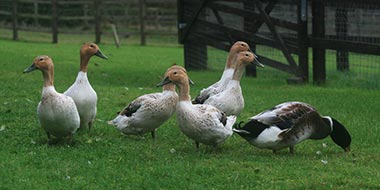
Abacot Ranger ducks are one of the breeds developed with the Indian Runner duck. The female has a deep-fawn hood and precise markings on the breast, which look like they have been painted on with an artist’s brush.
Ancona Chickens
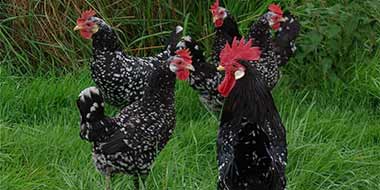
Ancona Chickens take their name from the eastern Italian City of Ancona. It is thought they first reached the shores of England in 1851. There are several views about the origins of the Ancona, some believing that it is very similar to the original Mottled Leghorn.
Silkie Chickens

Silkie Chickens are unique with pompom, 5th toe, black skin and profuse fluffy plumage: characteristics, genetics, incubation and lots of photos of the colours.
Springtime Worming

During the spring, poultry worms start to increase in numbers as the temperature holds above 10°C. It is a good idea to have a plan for springtime worming.
Keeping Chickens in Autumn and Planning for Winter
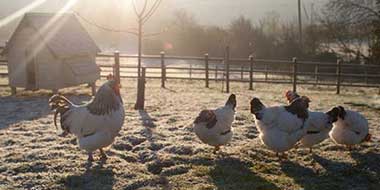
There are a few jobs to consider in autumn as well as some planning to prepare you and your birds for winter.
Fast Food: Raising Broiler Chickens

With huge welfare issues surrounding intensively reared chickens, raising broiler chickens (fast-growing chickens for meat) is becoming more popular with the smallholder.
Step-by-Step Guide to Composting Chicken Manure
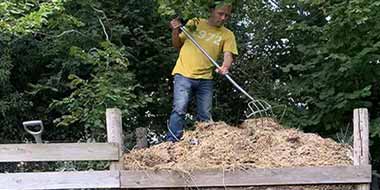
A complete fertiliser and an excellent source of organic matter, composted chicken manure provides you with a valuable commodity for your garden.
List of Poisonous Plants for Chickens
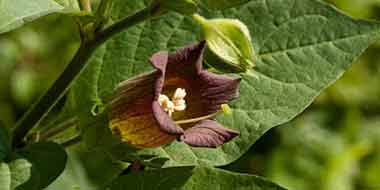
The last thing we want is to put our hens at risk of illness. This article provides a list of poisonous plants for chickens that you should avoid having in your chicken run and lists foods that you should not feed to your chickens. Chickens are curious and will scratch around, pecking at most things, […]
Assessing a Cockerel’s Temperament

Information on assessing a cockerel’s temperament, which is especially important if you have young children.
Identification with Poultry Leg Rings

If you are breeding or showing your birds, you will find it soon becomes necessary to use poultry leg rings. You can identify chickens, ducks, geese by a unique number printed on a leg ring which is registered to your name and address when you purchase them. Poultry leg rings allow you to prove ownership of […]
How To Use Artificial Light for Chickens
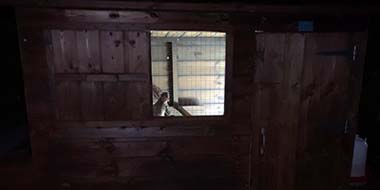
Light For Chickens Hens kept under natural daylight hours will lay the majority of their eggs during the spring and summer months. As the days shorten, egg production will decrease, and most pure breeds and hybrid hens will stop laying over the winter months. We can use a chicken coop light for chickens to keep […]
